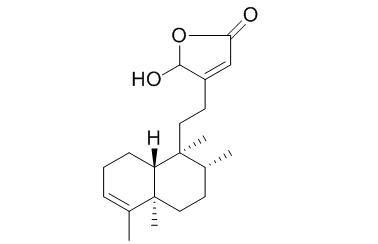16-Hydroxycleroda-3,13-dien-15,16-olide
16-Hydroxycleroda-3,13-dien-15,16-olide, and prodigiosin are presented as candidates for autophagy inducers that can trigger cell death in a supplement or alternative medicine for cancer therapy.
16-Hydroxycleroda-3,13-dien-15,16-olide regulates the expression of histone-modifying enzymes PRC2 complex and induces apoptosis in CML K562 cells. 16-Hydroxycleroda-3,13-dien-15,16-olide has anti-inflammatory activity, it shows promising NO inhibitory activity at 10 ug/mL.
Inquire / Order:
manager@chemfaces.com
Technical Inquiries:
service@chemfaces.com
Tel:
+86-27-84237783
Fax:
+86-27-84254680
Address:
1 Building, No. 83, CheCheng Rd., Wuhan Economic and Technological Development Zone, Wuhan, Hubei 430056, PRC
Providing storage is as stated on the product vial and the vial is kept tightly sealed, the product can be stored for up to
24 months(2-8C).
Wherever possible, you should prepare and use solutions on the same day. However, if you need to make up stock solutions in advance, we recommend that you store the solution as aliquots in tightly sealed vials at -20C. Generally, these will be useable for up to two weeks. Before use, and prior to opening the vial we recommend that you allow your product to equilibrate to room temperature for at least 1 hour.
Need more advice on solubility, usage and handling? Please email to: service@chemfaces.com
The packaging of the product may have turned upside down during transportation, resulting in the natural compounds adhering to the neck or cap of the vial. take the vial out of its packaging and gently shake to let the compounds fall to the bottom of the vial. for liquid products, centrifuge at 200-500 RPM to gather the liquid at the bottom of the vial. try to avoid loss or contamination during handling.
Metabolites2023, 13(1), 3.
Food Structure2023, 36:100324.
Phytomedicine.2023, 114:154813.
J Food Sci Technol.2019, 56(5):2712-2720
Journal of Functional Foods2024, 116:106186
Research Square2024, rs-4398438
Sci Rep. 2018, 1-9
BMB Rep.2018, 51(5):249-254
Horticulturae2022, 8(10), 975.
Medicina (Kaunas).2020, 56(12):685.
Related and Featured Products
Molecules. 2014 Feb 13;19(2):2049-60.
Three new clerodane diterpenes from Polyalthia longifolia var. pendula.[Pubmed:
24531220 ]
METHODS AND RESULTS:
Three new clerodane diterpenes, (4→2)-abeo-cleroda-2,13E-dien-2,14-dioic acid (1), (4→2)-abeo-2,13-diformyl-cleroda-2,13E-dien-14-oic acid (2), and 16(R&S)- methoxycleroda-4(18),13-dien-15,16-olide (3), were isolated from the unripe fruit of Polyalthia longifolia var. pendula (Annonaceae) together with five known compounds (4-8). The structures of all isolates were determined by spectroscopic analysis. The anti-inflammatory activity of the isolates was evaluated by testing their inhibitory effect on NO production in LPS-stimulated RAW 264.7 macrophages.
CONCLUSIONS:
Among the isolated compounds, 16-Hydroxycleroda-3,13-dien-15,16-olide (6) and 16-oxocleroda-3,13-dien-15-oic acid (7) showed promising NO inhibitory activity at 10 μg/mL, with 81.1% and 86.3%, inhibition, respectively.
Life Sci. 2011 Dec 5;89(23-24):886-95.
16-hydroxycleroda-3,13-dien-15,16-olide regulates the expression of histone-modifying enzymes PRC2 complex and induces apoptosis in CML K562 cells.[Pubmed:
21983300 ]
Histone modifications play central epigenetic roles in regulating the entire genome of the cell and cell proliferation. Herein, we investigated the effects of the natural compound, 16-Hydroxycleroda-3,13-dien-15,16-olide (PL3), on the expressions of histone-modifying enzymes, and examined how it induces apoptosis in leukemia K562 cells.
METHODS AND RESULTS:
Cell proliferation was determined by an MTT assay, and histone-modifying enzyme gene expressions were investigated by a quantitative real-time PCR. Protein expressions were analyzed by a Western blot analysis. The histone H3K27 distribution was observed with immunofluorescence staining. To verify polycomb repressive complex 2 (PRC2) complex downstream gene expressions, a gene-expression array was performed to determine gene regulations.
PL3 induced apoptosis and modulated many histone-modifying enzymes, especially the two PRC2 components, enhancer of zeste homolog 2 (EZH2) and suppressor of zeste 12 homolog (Suz12). Genes repressed by PRC2 were shown to be reactivated by PL3. Of these, 10 genes targeted by the PRC2 complex were identified, and expressions of 10 pro-/antiapoptotic genes were significantly regulated; these effects may have contributed to PL3-induced apoptosis in K562 cells. Regulation of other histone-modifying enzymes, including Aurora B, may also be involved in cell-cycle regulation.
CONCLUSIONS:
Our data suggest that the induction of apoptosis by PL3 might partly occur through both a reduction in PRC2-mediated gene silencing and the reactivation of downstream tumor suppressor gene expressions. PL3 acts as a novel small-molecule histone modulator, which can potentially contribute to cancer chemotherapy singly or as a combined medication.
Int J Mol Sci. 2017 Jul 1;18(7).
Natural Compounds from Herbs that can Potentially Execute as Autophagy Inducers for Cancer Therapy.[Pubmed:
28671583]
Accumulated evidence indicates that autophagy is a response of cancer cells to various anti-cancer therapies. Autophagy is designated as programmed cell death type II, and is characterized by the formation of autophagic vacuoles in the cytoplasm. Numerous herbs, including Chinese herbs, have been applied to cancer treatments as complementary and alternative medicines, supplements, or nutraceuticals to dampen the side or adverse effects of chemotherapy drugs. Moreover, the tumor suppressive actions of herbs and natural products induced autophagy that may lead to cell senescence, increase apoptosis-independent cell death or complement apoptotic processes.
METHODS AND RESULTS:
Hereby, the underlying mechanisms of natural autophagy inducers are cautiously reviewed in this article. Additionally, three natural compounds-curcumin, 16-Hydroxycleroda-3,13-dien-15,16-olide, and prodigiosin-are presented as candidates for autophagy inducers that can trigger cell death in a supplement or alternative medicine for cancer therapy.
CONCLUSIONS:
Despite recent advancements in therapeutic drugs or agents of natural products in several cancers, it warrants further investigation in preclinical and clinical studies.



